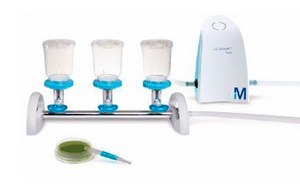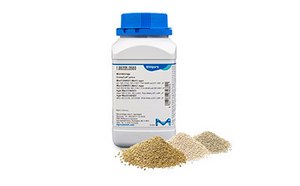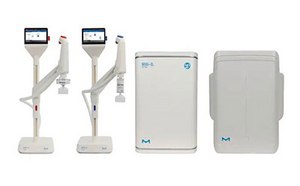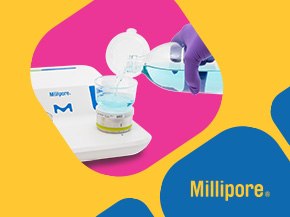Bioburden Testing
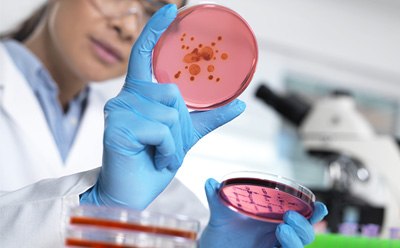
Bioburden is the presence of viable microorganisms on a surface (or complete item), inside a device, or in a portion of liquid, before sterilization. Bioburden can be introduced from the raw materials used in the manufacturing process or through the workforce in the manufacturing environment or during the packaging of end products. With numerous sources of potential contamination, the bioburden of a product can fluctuate between batches hence routine testing is implemented as a part of quality control.
Featured Categories
Speed up your time-to-result with rapid microbial testing using our complete membrane filtration systems; used in bioburden testing, food and beverage analysis, and cannabis microbiology testing.
Discover high-quality microbial culture media. Choose from dehydrated or ready-to-use options, meeting industry standards and regulatory requirements.
Milli-Q® systems offer innovative water purification technologies engineered to support lab research needs, sustainability goals, and other major requirements.
Fundamentals of Bioburden testing
Bioburden testing or Microbial testing is a quality control process that detects and quantifies microbial contamination of a product at different stages of production i.e., from initial manufacturing to final distribution. Effective quality control and accurate test results are essential to minimize risks for consumers and are required by regulated production environments. Therefore, bioburden analysis is often included in routine testing to ensure the safety, quality, and regulatory compliance of each manufactured product batch.
Bioburden testing is performed for medical devices, pharmaceuticals, food and beverages, water, packaging, raw materials, human tissue, animal tissue, and cosmetics. When standard methods, as described below are followed, it is important to ensure that the testing method does not introduce bacteria into the test sample or kill bacteria in the test sample.
Membrane Filtration Method for Bioburden Testing
Membrane filtration is the method of choice for products containing antimicrobial substances. In this method, the sample is passed through a membrane filter with a 0.45 µm pore size. The membrane functions as a barrier and captures microorganisms larger than the membrane pore size. During filtration, a vacuum can be used to speed up the process. The membrane is then transferred to a culture medium and placed in an incubator for at least 5 days at 30–35 °C for bacterial detection and at 20-25 °C for fungal detection. The resulting culture is further enumerated to determine the levels of microbial contamination in the sample. Appropriate measures should be taken to avoid cross-contamination that could lead to false-positive results.
Direct Plating Methods For Bioburden Testing
Direct plating methods for bioburden testing include pour plate and spread plate methods. The pour plate method is preferred due to its higher theoretical accuracy. In the pour plate method, the sterilized culture medium is added to a petri dish containing the test sample and allowed to solidify. Conversely, in the spread plate method, the sample is added to a petri dish containing sterile, solidified culture media. Regardless of the method, after the sample has been added to the culture system, the plate is incubated, and the resulting culture is enumerated.
Most Probable Number (MPN) Method For Bioburden Testing
The most probable number (MPN) method is a quantitative method used to determine the approximate bacterial concentration in a sample. The original solution or sample is subdivided by orders of magnitude (frequently 10× or 2×) into culture broth and assessed for the presence or absence of microorganisms. The drawback of the MPN method is that it requires large numbers of replicates at the appropriate dilution to narrow the confidence intervals. Furthermore, the method is only effective for bacterial examination and does not provide reliable results for the enumeration of fungi.
Visit our document search for data sheets, certificates and technical documentation.
Related Articles
- Milliflex® Quantum system enables rapid microbial contamination detection with fluorescence staining technology.
- Comparison of convenience, operating time, accuracy, costs and safety aspects of single-use funnels vs. reusable funnels for the membrane filtration method in QC microbiology.
- S-Pak® membrane filters for microbial bioburden testing
- Selective media enable faster results and visual confirmation for the detection, identification, and enumeration of microorganisms
- Water source comparison for microbiological media preparation highlights central purification vs. Milli-Q® IX system efficiency.
- See All (10)
Related Protocols
- Routine water and beverage microbiological analysis using the 55-Plus™ Monitor
- MicropreSure® on-line filtration system for in-process microbiology testing
- General protocols for growth of competent cells in microbial medium.
Find More Articles and Protocols
How Can We Help
In case of any questions, please submit a customer support request
or talk to our customer service team:
Email custserv@sial.com
or call +1 (800) 244-1173
Additional Support
- Chromatogram Search
Use the Chromatogram Search to identify unknown compounds in your sample.
- Calculators & Apps
Web Toolbox - science research tools and resources for analytical chemistry, life science, chemical synthesis and materials science.
- Customer Support Request
Customer support including help with orders, products, accounts, and website technical issues.
- FAQ
Explore our Frequently Asked Questions for answers to commonly asked questions about our products and services.
To continue reading please sign in or create an account.
Don't Have An Account?